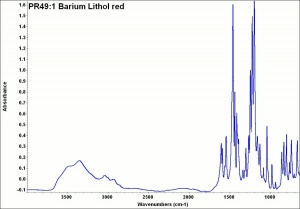Difference between revisions of "Lithol red"
(username removed) |
(username removed) |
||
| Line 1: | Line 1: | ||
| − | |||
== Description == | == Description == | ||
| − | [BASF] A trademark for a series of bright red, metallic salts of a synthetic [http://cameo.mfa.org/materials/fullrecord.asp?name=azo | + | [BASF] A trademark for a series of bright red, metallic salts of a synthetic [http://cameo.mfa.org/materials/fullrecord.asp?name=azo%20dye azo dye]. First patented in 1899 by Paul Julius (BASF), Lithol reds are made by combining Tobias acid (2-naphthylamine-1-sulfonic acid) and beta-naphthol. Variations in colors are obtained by forming the salts with [http://cameo.mfa.org/materials/fullrecord.asp?name=sodium sodium], [http://cameo.mfa.org/materials/fullrecord.asp?name=barium barium], [http://cameo.mfa.org/materials/fullrecord.asp?name=calcium calcium], and [http://cameo.mfa.org/materials/fullrecord.asp?name=strontium strontium] cations. Lithol reds are inexpensive and widely used in [http://cameo.mfa.org/materials/fullrecord.asp?name=printing%20ink printing inks], [http://cameo.mfa.org/materials/fullrecord.asp?name=crayon crayons], [http://cameo.mfa.org/materials/fullrecord.asp?name=enamel%2C%20organic enamels], stationery, and industrial paints. They are also used as a colorants in some [http://cameo.mfa.org/materials/fullrecord.asp?name=plastic plastics]. Lithol reds are not lightfast in sunlight and have only been used in student grade artists paints. |
- Na salt: yellowish red, PR 49, CI 15630, water soluble | - Na salt: yellowish red, PR 49, CI 15630, water soluble | ||
| Line 15: | Line 14: | ||
Lithol toner; Pigment Red 49; CI 15630; 1-sulfo-beta-naphthalene-azo-beta-naphthol; Harrison Red | Lithol toner; Pigment Red 49; CI 15630; 1-sulfo-beta-naphthalene-azo-beta-naphthol; Harrison Red | ||
| + | |||
| + | [[[SliderGallery rightalign|PR49-1 Barium Lithol red.jpg~FTIR]]] | ||
== Other Properties == | == Other Properties == | ||
| Line 32: | Line 33: | ||
== Additional Information == | == Additional Information == | ||
| − | H. A. L. Standeven, "The History and Manufacture of Lithol Red, A Pigment Used by Mark Rothko in his Seagram and Harvard Murals of the 1950s and 1960s" ''Tate Papers'', Issue 10, 2008. [http://cameo.mfa.org/materials/ http://www.tate.org.uk/research/tateresearch/tatepapers/08autumn/harriet-a-l-standeven.shtm Link] | + | º H. A. L. Standeven, "The History and Manufacture of Lithol Red, A Pigment Used by Mark Rothko in his Seagram and Harvard Murals of the 1950s and 1960s" ''Tate Papers'', Issue 10, 2008. [http://cameo.mfa.org/materials/ http://www.tate.org.uk/research/tateresearch/tatepapers/08autumn/harriet-a-l-standeven.shtm Link] º B.Berrie, S.Q.Lomax, "Azo Pigments: Their History, Synthesis, Properties and Use in Artists' Materials" in ''Studies in the History of Art'', No.57, National Gallery of Art, Washington DC, 1997. |
== Authority == | == Authority == | ||
| − | * | + | * R. J. Gettens, G.L. Stout, ''Painting Materials, A Short Encyclopaedia'', Dover Publications, New York, 1966 |
| − | * | + | * Ralph Mayer, ''A Dictionary of Art Terms and Techniques'', Harper and Row Publishers, New York, 1969 (also 1945 printing) |
* Art and Architecture Thesaurus Online, http://www.getty.edu/research/tools/vocabulary/aat/, J. Paul Getty Trust, Los Angeles, 2000 | * Art and Architecture Thesaurus Online, http://www.getty.edu/research/tools/vocabulary/aat/, J. Paul Getty Trust, Los Angeles, 2000 | ||
| − | * | + | * B. Berrie, S.Q. Lomax, 'Azo Pigments: Their History, Synthesis, Properties and Use in Artists' Materials', ''Studies in the History of Art'' , National Gallery of Art, Washington DC, No. 57, 1997 |
| − | * | + | * Thomas Gregory, ''The Condensed Chemical Dictionary'', Reinhold Publishing, New York, 3rd ed., 1942 |
| − | * | + | * Michael McCann, ''Artist Beware'', Watson-Guptill Publications, New York City, 1979 |
[[Category:Materials database]] | [[Category:Materials database]] | ||
Revision as of 06:35, 24 July 2013
Description
[BASF] A trademark for a series of bright red, metallic salts of a synthetic azo dye. First patented in 1899 by Paul Julius (BASF), Lithol reds are made by combining Tobias acid (2-naphthylamine-1-sulfonic acid) and beta-naphthol. Variations in colors are obtained by forming the salts with sodium, barium, calcium, and strontium cations. Lithol reds are inexpensive and widely used in printing inks, crayons, enamels, stationery, and industrial paints. They are also used as a colorants in some plastics. Lithol reds are not lightfast in sunlight and have only been used in student grade artists paints.
- Na salt: yellowish red, PR 49, CI 15630, water soluble
- Ba salt: bluish pink, PR 49:1, CAS 1248-18-6
- Ca salt: bright red, PR 49:2, CAS 1103-38-4
- Sr salt: purplish red, PR 49:3, CAS 1103-39-5
Synonyms and Related Terms
Lithol toner; Pigment Red 49; CI 15630; 1-sulfo-beta-naphthalene-azo-beta-naphthol; Harrison Red
Other Properties
Poor lightfastness
| Composition | C20H14N2O4S |
|---|
Hazards and Safety
May cause allergic reactions. May be contaminated with cancer causing chemicals.
Additional Information
º H. A. L. Standeven, "The History and Manufacture of Lithol Red, A Pigment Used by Mark Rothko in his Seagram and Harvard Murals of the 1950s and 1960s" Tate Papers, Issue 10, 2008. http://www.tate.org.uk/research/tateresearch/tatepapers/08autumn/harriet-a-l-standeven.shtm Link º B.Berrie, S.Q.Lomax, "Azo Pigments: Their History, Synthesis, Properties and Use in Artists' Materials" in Studies in the History of Art, No.57, National Gallery of Art, Washington DC, 1997.
Authority
- R. J. Gettens, G.L. Stout, Painting Materials, A Short Encyclopaedia, Dover Publications, New York, 1966
- Ralph Mayer, A Dictionary of Art Terms and Techniques, Harper and Row Publishers, New York, 1969 (also 1945 printing)
- Art and Architecture Thesaurus Online, http://www.getty.edu/research/tools/vocabulary/aat/, J. Paul Getty Trust, Los Angeles, 2000
- B. Berrie, S.Q. Lomax, 'Azo Pigments: Their History, Synthesis, Properties and Use in Artists' Materials', Studies in the History of Art , National Gallery of Art, Washington DC, No. 57, 1997
- Thomas Gregory, The Condensed Chemical Dictionary, Reinhold Publishing, New York, 3rd ed., 1942
- Michael McCann, Artist Beware, Watson-Guptill Publications, New York City, 1979
